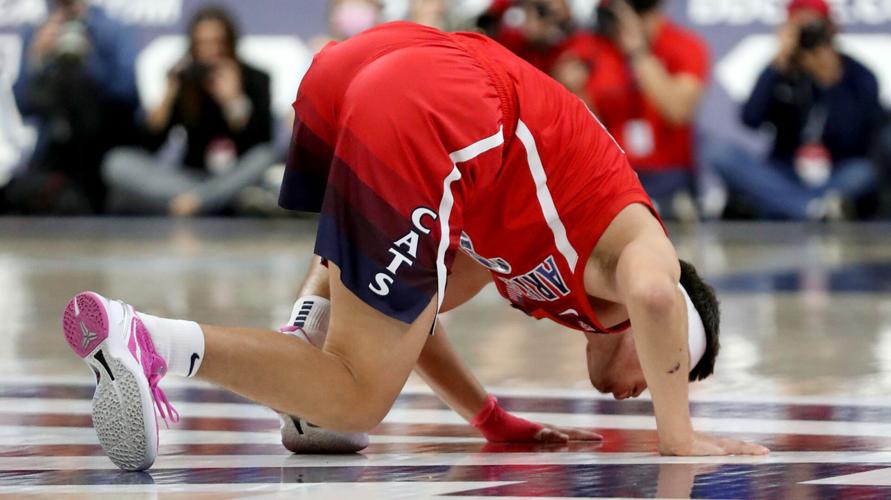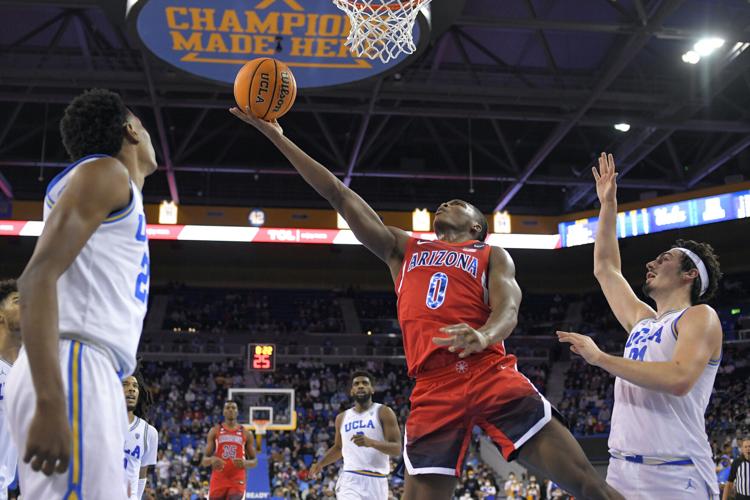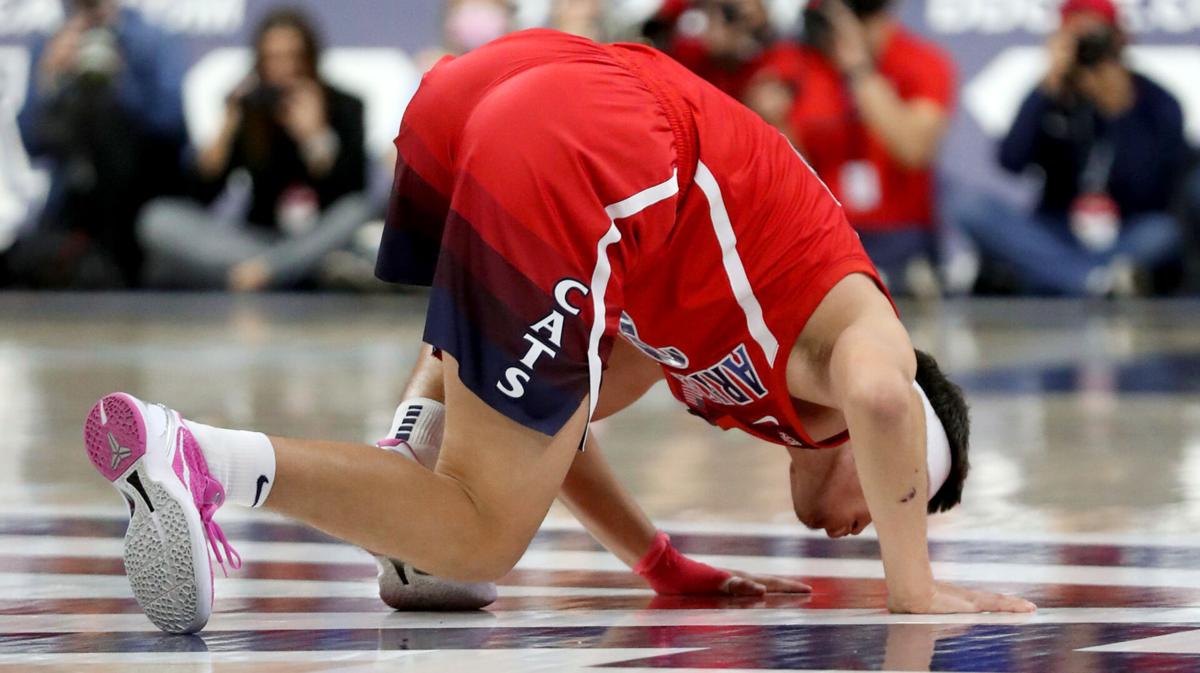In Tommy Lloyd’s last three seasons as Gonzaga’s primary offensive coordinator, the Zags were a force of nature.
They finished No. 1, No. 2 and No. 1 in college basketball scoring. They never shot lower than 51% in a season, the NCAA’s leading cumulative figure over that period. By comparison, Arizona has shot 50% in a season once (2017-18) since 1992.
More impressive, the collaboration between Lloyd and Zags head coach Mark Few was so effective that Gonzaga shot less than 40% in just six of 341 games the last nine seasons. That’s an eye-blinking, head-shaking statistic that may never be repeated anywhere.
Playing 16 games per season in the weak West Coast Conference has a lot to do with those numbers; the offensive force of nature Few and Lloyd created at Gonzaga may not always work as well in the Pac-12.
Over the last few days, nature has fought back.
Arizona shot 31% at UCLA and 32% against ASU. Now comes Thursday’s rematch against UCLA and coach Mick Cronin, who is the Pac-12’s master defensive tactician. To get a historical context on what the odds are of another sub-40% shooting night by the Wildcats, consider this:
The last time Arizona shot less than 40% in three consecutive games was December 1963. Lloyd and Cronin hadn’t been born yet.
Dec. 4, 1963: Arizona shot 39% in a loss to Evansville.
Dec. 6, 1963: Arizona shot 32% in a loss at Colorado.
Dec. 7, 1963: Arizona shot 39% in a loss at Colorado State.
It’s almost mind-blowing that we’re even discussing this. Lloyd’s Wildcats opened the season with such a blur of nation-leading offensive numbers — Arizona shot .560, .509, .608 and .554 in consecutive Pac-12 blowouts over Washington, Colorado, Utah and Stanford — that it seemed invulnerable to any type of defensive intervention.
Almost.

Arizona guard Bennedict Mathurin, center, shoots during last week’s loss at UCLA. The Wildcats face the defensive-minded Bruins again Thursday at McKale Center.
The UA-ASU game was the most inartistic Territorial Cup game in more than 50 years. ASU shot just 33% compared to UA’s 32%. The last time the Sun Devils and Wildcats shot so poorly against one another was 1967 — ASU won a 73-67 game in which it shot 32% and Arizona 39%.
On Saturday, Lloyd said, “I haven’t been part of any game like that.’’
Yet he’s calling the same plays and running the same offense as he did when Arizona shot 50% in a win over then-No. 4 Michigan and 53% over a then-unbeaten Wyoming team which is now 16-3.
It simply means that sometimes good calls and good plays don’t work, especially against better competition.
This is something of a first at Arizona dating to Lute Olson’s first seasons. The Wildcats didn’t have long-lasting shooting slumps, but rather, epic offensive failures in some of the most important games in school history. Such as:
In Olson’ first NCAA Tournament game at Arizona, the Wildcats shot 29% in a first-round 51-40 loss to Alabama in 1985.
In a surprising first-round setback to Miami of Ohio in 1995, Damon Stoudamire’s last game at Arizona, the Wildcats shot 37%.
In perhaps the most bitter loss in school history, a 76-51 Elite Eight shocker to Utah, 1998, the Wildcats shot 28%. Mike Bibby, Michael Dickerson and Miles Simon combined to shoot 6 for 36.
In Elite Eight losses to UConn, 2011, and Wisconsin, 2014, the Wildcats shot 39% in each game.
Fortunately for Lloyd, his club has plenty of time for redemption.
“We have to evaluate the type of shots we’re getting, that our offense is getting us, and the types of decisions we’re making on those shots,’’ he said after the ASU game. “Are we turning down good shots to take tougher shots? Who do we want to taking those shots, where do we want to get them within our offense?’’
As with all coaches in college basketball, Lloyd carries scars of epically bad shooting performances at the worst possible time. His Gonzaga teams went home in tears multiple times.
In the 2017 national championship game against North Carolina, the Zags shot 34%.
In the 2018 Sweet 16, Gonzaga shot 33% in a loss to Florida State.
In the 2013 Round of 32, Gonzaga shot 35% in a loss to Wichita State.
To combat scoring difficulties, some of the most honored names in college basketball coaching history, including Oregon State’s Ralph Miller, have gone to extremes.
In the most bizarre game in modern Pac-12 history, No. 2 Oregon State won 18-16 at Stanford in 1980. The Cardinal employed a four-corners slowdown. Miller’s team struggled, shooting just 33%. Yet the Beavers took an 18-16 lead with nine minutes remaining then made the choice to sit on the ball themselves.
There was no shot clock in 1980. Oregon State didn’t take a shot in the last nine minutes, gambling it could keep Stanford from scoring on a last-possession play. Bingo. Stanford traveled with nine seconds remaining and the Beavers won 18-16.
“It was a great experience for us,’’ Miller said. “A character builder.’’
Oregon State, 26-3, went on to win the Pac-12, entering the NCAA Tournament as a No. 2 seed and huge favorite over the obscure Lamar Cardinals. Alas, unable to make a basket in the final two minutes, the Beavers lost 81-77.
As Lloyd has learned, a shooting slump in March is much worse than one at mid-season.






